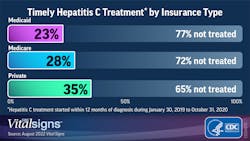A new CDC Vital Signs report finds that too few people diagnosed with hepatitis C are being treated, despite availability of medications capable of curing this viral infection.
According to CDC’s estimates:
- Overall, less than 1 in 3 people with health insurance get direct-acting antiviral (DAA) treatment for hepatitis C within a year of diagnosis.
- Treatment is lowest among patients in state-administered Medicaid plans, with less than 1 in 4 Medicaid recipients (23%) being treated within a year of diagnosis.
- Additionally, Medicaid recipients in states that restrict access to hepatitis C treatment are 23% less likely to receive treatment than Medicaid recipients in states without restrictions.
Hepatitis C is curable with well-tolerated, oral medication. Untreated, hepatitis C can cause liver disease, liver cancer, and death. Treatment prevents illness and death, stops spread of hepatitis C, and is cost-saving. In 2019, hepatitis C contributed to the deaths of more than 14,000 people in the United States.
- For the past several years, CDC’s annual hepatitis C data have shown the highest rates of new infection among adults under 40, indicating that treating this group is critical. However, this new analysis found adults under 40 have the lowest treatment rates by age group.
- Among those under age 40, hepatitis C is most commonly spread through injection drug use.
To ensure people diagnosed with hepatitis C are treated, healthcare providers, insurers, policy makers, and public health professionals should:
- Remove eligibility restrictions and preauthorization requirements that make it difficult for people with hepatitis C to access treatment that will cure the infection.
- Provide treatment where people already receive services, such as primary care offices, community clinics, syringe services programs, substance use treatment centers, and correctional facilities.
- Provide treatment in as few visits as possible.
- Expand the number of primary care providers treating hepatitis C.
CDC recommends that everyone get tested for hepatitis C at least once in their lifetime and that people with ongoing risk factors for hepatitis C receive routine periodic testing.

